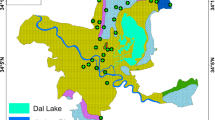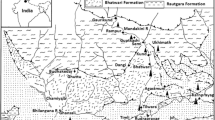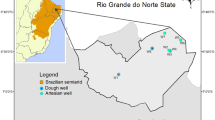Abstract
Radon (222Rn) is radium’s immediate radioactive decay product (226Ra) in the uranium decay series. Radon is classified as a group 1 carcinogen due to its hazard to human health, and the evaluation of radon concentrations has become essential. Therefore, an advanced method was applied to a liquid scintillation counter (Hidex 300SL) to measure the radon concentration in groundwater. The estimated radon concentration was between 0.1 and 3.20 Bq/L, with an average of 0.96 Bq/L and with a standard deviation of 0.82 Bq/L. The estimated radon concentrations are in the safe range recommended by the United States Environmental Protection Agency (USEPA) and European Atomic Energy Community (EAEC). However, the values are far below the safe range set by the United Nations Scientific Committee on the Effects of Atomic Radiation (UNSCARE), European Commission (EC), and World Health Organization (WHO) standards. Nevertheless, the estimated radon concentration by this advanced application ensured no risk of radon exposure from the groundwater of the tested area.
Graphical Abstract





Similar content being viewed by others
Data availability
The dataset used in this study is available from the corresponding author upon reasonable request except for data that are subject to third-party restrictions.
References
Abojassim A (2014) Radon concentrations measurement for drinking water in Kufa City /Iraq using active detecting method. Advances in Physics, Theories and Applications 26:6
Abuelhia E (2017) Evaluation of annual effective dose from indoor radon concentration in Eastern Province, Dammam, Saudi Arabia.Radiat Phys Chem 140:137-140
Abuelhia E (2019) Assessment of radiation dose from radon ingestion and inhalation in commercially bottled drinking water and its annual effective dose in Eastern Province, Saudi Arabia. Int J Environ Health Res 29:164–172
Al-Bataina BA, Ismail AM, Kullab MK, Abumurad KM, Mustafa H (1997) Radon measurements in different types of natural waters in Jordan. Radiat Meas 28(1):591–594. https://doi.org/10.1016/S1350-4487(97)00146-7
Aleissa KA, Alghamdi AS, Almasoud FI, Islam MS (2012) Measurement of radon levels in groundwater supplies of Riyadh with liquid scintillation counter and the associated radiation dose. Radiat Prot Dosimetry 154:95–103
Aleissa KA, Alghamdi AS, Almasoud FI, Islam MS (2013) Measurement of radon levels in groundwater supplies of Riyadh with liquid scintillation counter and the associated radiation dose. Radiat Prot Dosimetry 154:95–103
Aljaloud KB, ElBatouti M (2021) Statistical analysis of 222Rn concentration in Zamzam and other water sources in the Kingdom of Saudi Arabia. Heliyon 7:e06057
Al-Jaseem QK, Almasoud FI, Ababneh AM, Al-Hobaib AS (2016) Radiological assessment of water treatment processes in a water treatment plant in Saudi Arabia: water and sludge radium content, radon air concentrations and dose rates. Sci Total Environ 563–564:1030–1036
Alsharhan AS, Rizk ZA, Nairn AEM, Bakhit DW, Alhajari SA (2001) ‘Preface’, hydrogeology of an arid region: the Arabian Gulf and adjoining areas. Elsevier Science B.V, Amsterdam, pp 287–309
Althoyaib S, El-Taher A (2015) Natural radioactivity measurements in groundwater from Al-Jawa, Saudi Arabia. J Radioanal Nucl Chem 304:547–552
Aly AA, Al-Omran AM, Alharby MM (2015) The water quality index and hydrochemical characterization of groundwater resources in Hafar Albatin, Saudi Arabia. Arab J Geosci 8:4177–4190
Amrani D (2002) Natural radioactivity in Algerian bottled mineral waters. J Radioanal Nucl Chem 252(3):597–600
Arun B, Viswanathan S, Venkatesan S, Jose MT, Balasubramaniam V (2021) Study of triple to double coincidence method for tritium measurements. Radiochemistry 63:221–226
Asuni G, Al Qahtani S, Khasawinah S (2021) Occupational radon assessment in underground storage facilities in Saudi Arabia. Health Physics Publish
Broda R (2003) A review of the triple-to-double coincidence ratio (TDCR) method for standardizing radionuclides. Appl Radiat Isot 58:585–594
Choppin GR, Liljenzin J-O, Rydberg JAN (2002) CHAPTER 5 - Radionuclides in Nature. In: Choppin GR, Liljenzin J-O, Rydberg JAN (eds) Radiochemistry and Nuclear Chemistry, 3rd edn. Butterworth-Heinemann, Woburn, pp 94–122
De Simone G, Galli G, Lucchetti C, Tuccimei P (2015) Calibration of Big Bottle RAD H2O set-up for radon in water using HDPE bottles. Radiat Meas 76:1–7
Durrani SA (1999) Radon concentration values in the field: correlation with underlying geology. Radiat Meas 31:271–276
EC (2019) Radon in workplaces: implementing the requirements in Council Directive. Publications Office
El-Araby E (2018) Direct measurement of the radioactive radon gas activity in water in Saudi Arabia, 020019 pp
El-Araby EH, Soliman HA, Abo-Elmagd M (2019) Measurement of radon levels in water and the associated health hazards in Jazan, Saudi Arabia. Journal of Radiation Research and Applied Sciences 12:31–36
El-Taher A (2012) Annual effective dose exposure in ground water from Qassim area, Saudi. J Environmen Sci Techn 5(6):475–481
El-Taher A, Al-Turki A (2016) Radon activity measurements in irrigation water from Qassim Province by RAD7. J Environ Biol 37:1299–1302
El-Taher AM, Abojassim AA, Najam LA, Mraity HAAB (2020) Assessment of annual effective dose for different age groups based on radon concentrations in the groundwater of Qassim, Saudi Arabia. Iranian Journal of Medical Physics 17:15–20
Gebresilasie KG, Berhe GG, Tesfay AH, Gebre SE (2021) Assessment of some physicochemical parameters and heavy metals in hand-dug well water samples of Kafta Humera Woreda, Tigray, Ethiopia. International Journal of Analytical Chemistry 2021:8867507
Harrison JD (2021) Lung cancer risk and effective dose coefficients for radon: UNSCEAR review and ICRP conclusions. J Radiol Prot 41:433–441
Hopke PK, Borak TB, Doull J, Cleaver JE, Eckerman KF, Gundersen LCS, Harley NH, Hess CT, Kinner NE, Kopecky KJ, McKone TE, Sextro RG, Simon SL (2000) Health risks due to radon in drinking water. Environ Sci Tech 34:921–926
Idriss H, Salih I, Sam A (2011) Study of radon in ground water and physicochemical parameters in Khartoum state. J Radioanal Nucl Chem 290(2):333–338
Kendall GM, Smith TJ (2002) Doses to organs and tissues from radon and its decay products. J Radiol Prot 22:389–406
Küçükönder E, Gümbür S (2022) Radon gas measurement in water samples in Kahramanmaras Province of Turkey. Water, Air, Soil Pollut 233:175
Kuo M-C (2023) ‘Methods of monitoring groundwater radon, pp. 5-20
Lucas LL, Unterweger MP (2000) Comprehensive review and critical evaluation of the half-life of tritium. J Res Nat Inst Stand Technol 105:541–549
Malakootian M, Nejhad YS (2017) Determination of radon concentration in drinking water of Bam villages and evaluation of the annual effective dose. Int J Radiat Res 15(1):81
Malik MFI, Rabaiee NA, Jaafar MS (2015) ‘Determination of radon concentration in water using RAD7 with RAD H2accessories’, National Physics Conference 2014 (PERFIK 2014), p. 120005
Maringer FJ, Baumgartner A, Rechberger F, Seidel C, Stietka M (2013) Activity measurement and effective dose modelling of natural radionuclides in building material. Appl Radiat Isot 81:279–283
Martin JE (2006) Physics for radiation protection: a handbook. John Wiley & Sons
Massoud E, El-Taher A, Elmoniem A, Elzain AEA, El-Taher A, Elzain A (2020) Estimation of environmental radioactivity and radiation dose from exposure to radon in groundwater for inhabitants in Qassim Area, Saudi Arabia. Desalin Water Treat 205:308–315
Mehra R, Bala P (2014) Estimation of annual effective dose due to Radon level in indoor air and soil gas in Hamirpur district of Himachal Pradesh. J Geochem Explor 142:16–20
Moldovan M, Nita DC, Cucos-Dinu A, Dicu T, Bican-Brişan N, Cosma C (2014) Radon concentration in drinking water and supplementary exposure in Băiţa-Ştei mining area, Bihor county (Romania). Radiat Prot Dosimetry 158(4):447–452
Salvato C (2003) The role of micro-strategies in the engineering of firm evolution. J Manag Stud 40:83–108
Seoud M (2018) Measurement of radon-222 concentration in bottled natural mineral drinking water in Kuwait using the nuclear track detector (CR-39)
Tayyeb Z, Kinsara A, Farid S (1998) A study on the radon concentrations in water in Jeddah (Saudi Arabia) and the associated health effects. J Environ Radioact 38:97–104
UNSCEAR (1988) ‘Sources’, Effects and Risks of ionizing Radiation 199
UNSCEAR (2000) The general assembly with scientific annex. United Nations
USEPA (1991) National primary drinking water regulations; Radionuclides, proposed rule. Fed. Reg. 56:33050–33127
USEPA (2000) National primary drinking water regulations; radionuclides; final rule. Fed. Reg. 65:76708
Vincent P (2008) Saudi Arabia: an environmental overview. CRC Press, London
WHO (2007) Desalination for safe water supply: Guidance for the Health and Environmental Aspects Applicable to Desalination. World Health Organization
WHO (2011) Guidelines for drinking-water quality. World Health Organization, pp 303–304
Xinwei L (2006) Analysis of radon concentration in drinking water in Baoji (China) and the associated health effects. Radiat Prot Dosimetry 121(4):452–455
Yalım HA, Sandıkcıoğlu A, Ünal R, Orhun Ö (2007) Measurements of radon concentrations in well waters near the Akşehir fault zone in Afyonkarahisar, Turkey. Radiat Meas (3):505–508
Acknowledgements
The authors thank the Deanship of Scientific Research, University of Hafr Al Batin, for the experimental facilities.
Funding
This work is financially supported by the Institutional Funding Project (No: IFP-A-202-1-3) from the Ministry of Education, Saudi Arabia.
Author information
Authors and Affiliations
Corresponding author
Ethics declarations
Conflict of interest
The authors declare no competing interests.
Additional information
Responsible Editor: Broder J. Merkel
Supplementary information
ESM 1
(DOCX 107 kb)
Rights and permissions
Springer Nature or its licensor (e.g. a society or other partner) holds exclusive rights to this article under a publishing agreement with the author(s) or other rightsholder(s); author self-archiving of the accepted manuscript version of this article is solely governed by the terms of such publishing agreement and applicable law.
About this article
Cite this article
Mamun, A., Alazmi, A.S. Advance application of liquid scintillation counter to estimate radon concentration in groundwater. Arab J Geosci 17, 34 (2024). https://doi.org/10.1007/s12517-023-11846-8
Received:
Accepted:
Published:
DOI: https://doi.org/10.1007/s12517-023-11846-8




